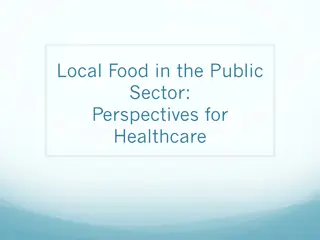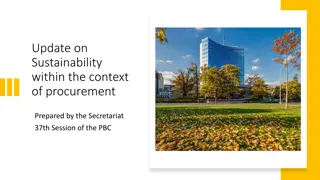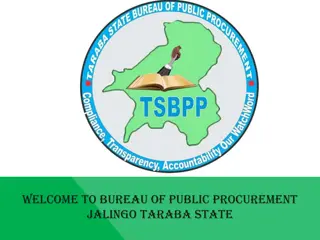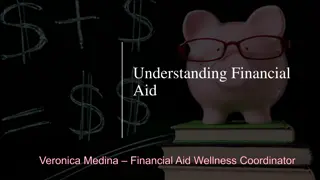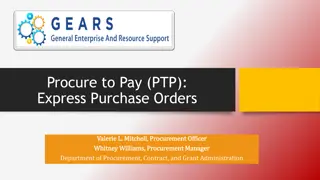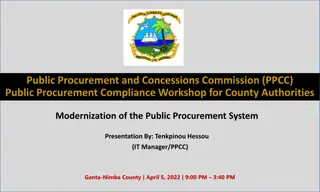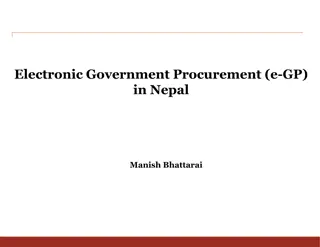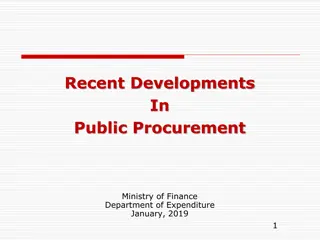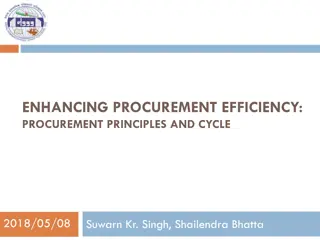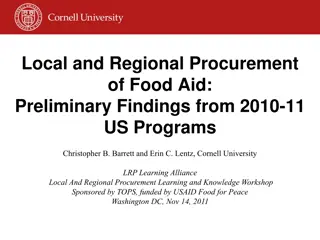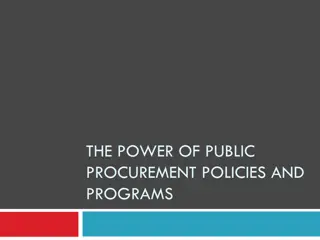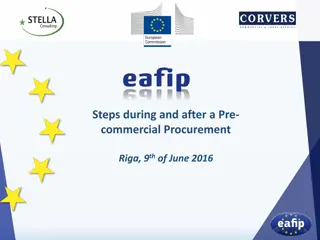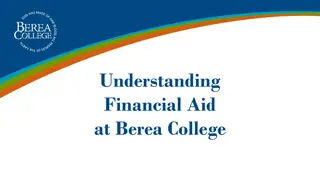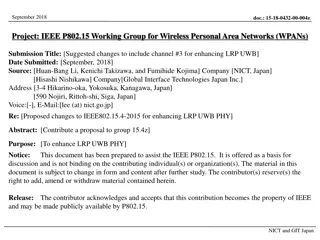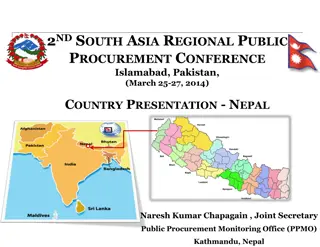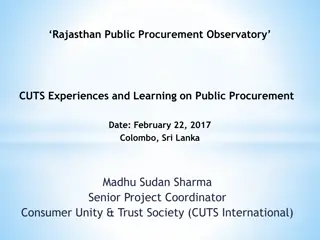Understanding Local and Regional Procurement (LRP) Initiatives in Food Aid Programs
Local and Regional Procurement (LRP) initiatives involve sourcing food aid locally to reduce delivery costs, delays, and market distortions. They aim to provide economic opportunities for small farmers while addressing potential negative impacts on local markets. Strategies such as cash transfers and food vouchers are used to ensure food aid reaches beneficiaries efficiently while maintaining market stability. Challenges include market disruptions and disincentives for local producers, but LRP offers advantages in procurement flexibility and supporting local economies.
Download Presentation

Please find below an Image/Link to download the presentation.
The content on the website is provided AS IS for your information and personal use only. It may not be sold, licensed, or shared on other websites without obtaining consent from the author. Download presentation by click this link. If you encounter any issues during the download, it is possible that the publisher has removed the file from their server.
E N D
Presentation Transcript
What is it? Who is promoting LRP initiatives? How s it being used? What are the advantages? Challenges? Examples?
Do No Harm Food Aid Potential negative impact of food aid on local markets Food aid displaces commercial food sales Food aid deliveries increase supply faster than they increase demand, thus depressing the food prices received by producers and traders Low prices translate into a disincentive for producers to invest in improved technologies or for marketing agents to bring in commercial supplies or invest in storage and transport capacity The receipt of food aid may cause households to reduce their labor supply, discourage household investment in agricultural production and crowd out private transfers and community level safety nets.
Do No Harm Cash/vouchers Potential negative impact of cash/vouchers on local markets If the increase in demand is not matched by increased supply, prices will increase, affecting both beneficiaries and non- beneficiaries Reinforcing non-competitive market structures
Main reasons for LRP 1.Reduce delivery costs, delays and market distortion. 2.Increase procurement flexibility while providing economic opportunities for small farmers/cooperatives.
Mechanisms for Implementation of Local Purchase Tenders Vouchers Cash for Work Vouchers for Work Food for Work Food Coupons Others?
Cash transfers the provision of cash to food insecure beneficiaries who lack economic access to food stocks that are readily available in the local markets of the affected country. Key is functioning market system. Food vouchers - the provision of vouchers that are redeemable for food to food insecure beneficiaries who lack economic access to food stocks that are readily available in the local markets of the affected country.
History of Local/Region Procurement World Food Program 2008 Food Conservation and Energy Act or Farm Bill (Authorizing legislation for US food aid) USDA LRP Pilot Program GAO Study (2009) USAID/EFSP Program
CRS Local/Regional Purchases 2000-2008 20 Countries Over $9.8 million Over 22,400 metric tons Over 114 transactions Donors: CRS-HQ, USAID/PEPFAR, USAID/OFDA USDA/FFE, Church of Jesus Christ of Latter Day Saints Various CARITAS members, Government of UK (DFID) Government of Ireland, Government of Germany World Bank, MCC, Concern Universal
Recent US Funded LRP for CRS 8 Projects - Guatemala, Nicaragua, Benin, Burkina Faso, Niger (2), Mali, Afghanistan Total value of approximately $18 million
Trends, Current Status of C&V Food for Peace Overall budget: $1.2 billion LRP, C&V: $300 million (25%) ECHO 2007: 2% food assistance budget on C&V, 12% projects 2010: 20% food assistance budget on C&V, 42% projects WFP 2009: $54 million in cash and voucher programs 2010: $123 million in cash and voucher programs USDA LRP Pilot: $60 million over 4 years LRP and vouchers, no cash
USDA LRP Pilot 4 Phases - Study, Guidelines, Projects, Evaluation $60 Million over 4 years 3 Goals - Emergency, Development, Do No Harm USDA LRP Development Interventions
GAO Study May 2009 GAO = Government Accountability Office (US) Why GAO did the study What GAO found GAO Recommendations
USAID Emergency Food Security Program (EFSP) FY 10/11 Congressional Budget Justification Request for Emergency Food Security funding Included LRP food vouchers/cash transfers - April 2010 APS - April 2011 APS that requested a response with Title II resources, LRP (vouchers/cash) or a combination of both
Comparing Cash and Vouchers Benefits of Vouchers Gives beneficiaries varying levels of choice, while still having some control over how the transfer is used. Vouchers can be targeted within the household, so it can potentially give more decision-making power to females (Sustainability?) Ability to learn more about consumer/beneficiary preferences and demand. This information can be used in future programming.
Comparing Cash and Vouchers Disadvantages of vouchers vis- -vis cash Higher administrative costs for vouchers than cash More decisions on programmatic design, e.g. number of vouchers/distribution, voucher denominations, criteria for and number of participating vendors Vouchers can be exclusionary, particularly with respect to small vendors that are difficult to include in voucher schemes. Do no harm principles. Tradeoff between increased consumer benefit/vendor inclusion and administrative costs,
Delivery Mechanisms Cash/paper voucher distributions Microfinance Institutions/Banks Barcodes Smart cards Mobile phones
Opportunities of new methodologies Provide more choice and dignity to the beneficiaries that we serve Respond quicker and more efficiently Support local market actors and local production Integration of emergency food security responses with longer-term food security programming, e.g. increasing agricultural productivity, linking farmer groups to markets, improving food quality standards, support to small traders and businesses
Advantages of LRP Timeliness Cost Management Adaptability to local tastes and conditions Empowerment of Beneficiaries Priming Markets for Smallholder Farmers Link from Producers to Markets
Challenges with LRP Better Understanding local/regional markets, Market analysis Food Quality and Safety Issues (Do No Harm) High Level of Monitoring required Timeliness in following agency procedures Unfamiliarity of sellers with agency buying procedures Timeliness of delivery Market distortion concerns Local government regulations/taxes Price fluctuations/budgeting Limited supply base (food insecure areas) Co-ordination with other agencies in the market
Food Quality and Safety Testing Testing of Mycotoxins - Lab or field test? Cost? Conform to laws and standards in each country at minimum Only 14 African countries have standards for aflatoxins Moisture meters/REVEAL tests for outlying areas Capacity of National Laboratories WFP s Blue Box (P4P)
Group Exercise Case Studies Context Why do we need a response? Target beneficiary group(s) Size of grant/procurement (MT) Mechanism used for response (cash, voucher, FFW, etc.) Results/Sustainability Other important elements to note?
Case Study 1 CRS Guatemala Response to drought and tropical storm Agatha 3,000 HH / 18,000 Individuals (EFSP) Corn, Black Beans, Incaparina Semi-competitive bids accepted from farmer- based and commercial organizations Agreement signed 9/20/2010 First distribution to beneficiaries in Santa Rosa on 10/25/2010
Case Study 2 Burkina Faso Response to food insecurity among school aged children in target zone (Development) Students, Producers (Coops and CFGs), PTAs One year pilot for $985,965 (USDA) Vouchers, Tender Cost and Time efficient, increased capacity of local producers, boost in local economy Video
Case Study 3 CRS Niger 1stvoucher program in Niger (USAID EFSP) Followed up by USDA LRP Emergency program Total of 300,000 beneficiaries and $8 million 25% Female Head of Household Vouchers for 6 commodities (added gari and sugar in second project) for approved vendors Wholesalers and Retailers Consumers not covered under voucher program may have paid more due to delays?
Cost Comparison CRS MALI Commodity PRICE/Kg - $ MT Cost Locally Procured Millet $0.41 35.14 $14,522 Rice $0.82 2.5 $2,060 Cowpeas $0.74 7.53 $5,593 TOTAL $22,175 Imported from US Corn Meal $1.88 35.14 $66,063 Rice $2.26 2.50 $5,650 Split Peas $2.67 7.53 $20,105 TOTAL $91,818 Cost Savings $69,643 Percent Savings 76%
Cornell Component Benefit of partnership between development organizations and universities Lead role in developing tools for data collection and analysis Increased evidence base Better data to analyze impact/raise awareness of issues Improved advocacy efforts for LRP
Focus of Cornell Analysis Pilot tools for monitoring and collection of market price data that enable uniform data processing and analysis that will ensure high quality results reporting, review and analysis of overall results for all programs. PriceImpact Timeliness Cost- Effectiveness Recipient Satisfaction
Tools to Design Interventions MIFIRA Market Information and Food Insecurity Response Analysis (Cornell) EMMA Emergency Market Mapping Analysis EFSA Emergency Food Security Assessments LEGS Livestock Emergency Guidelines and Standards SSSA Seed System Security Analysis
LA Goal To coordinate monitoring of price data to ensure that LRP programs do not negatively affect local and regional markets, and to coordinate data analysis among the various programs.
LRP LA Main Activities Trainings (online and regional) Database development Database management Data analysis Reporting
LRP LA Meeting Nairobi Closer Look at Global Indicator Framework (monitoring, pre/post procurement, post distribution indicators) Future activities Advocacy Day in DC for partners/donors Presentations to influence next Farm Bill
LRP Way Forward What could be next steps for advancing this topic? Examples: LRP Programs have positive food security impacts for the duration of the program. But how can we improve the sustainability of these impacts? Strengthening the evidence base New donor policy Task force/Working Groups
Recommended LRP Reading GAO Study (May 2009) CARE White Paper (2006) WFP s Revolution: From Food Aid to Food Assistance 2006 OECD Study The Development Effectiveness of Food Aid: Does Tying Matter? Michigan State University Local and Regional Food Aid Procurement




